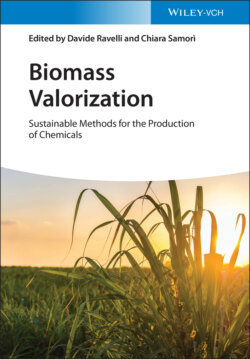Читать книгу Biomass Valorization - Группа авторов - Страница 2
Table of Contents
Оглавление1 Cover
4 Foreword
5 Preface
6 1 Role of Biomass in the Production of Chemicals 1.1 Introduction 1.2 Biomass Valorization 1.3 Lignocellulosic Biomass 1.4 Key Biomolecules 1.5 Solvents 1.6 Pretreatment of Lignocelluloses 1.7 Conclusions and Perspectives References
7 Section I: Catalytic Strategies 2 Biomass Processing via Acid Catalysis 2.1 Introduction 2.2 Acid‐Catalyzed Processing of Cellulosic Polysaccharides 2.3 Acid‐Catalyzed Processing of Lignin 2.4 Conclusions and Perspectives References 3 Biomass Processing via Base Catalysis 3.1 Introduction 3.2 Aldol Condensation 3.3 Ketonization Reaction of Carboxylic Acids 3.4 Transesterification Reaction 3.5 Conclusions and Perspectives References 4 Biomass Processing via Metal Catalysis 4.1 Introduction 4.2 Synthetic Strategies for Supported Metal Nanoparticles 4.3 Furfural 4.4 5‐Hydroxymethylfurfural (HMF) 4.5 Conclusions and Perspectives References 5 Biomass Processing with Biocatalysis 5.1 Introduction 5.2 Generations of Renewable Biomass: Advantages and Limitations 5.3 Advantages and Limitations of Biocatalysis 5.4 Enzyme Discovery and Optimization of Enzyme Performance 5.5 Enzyme Immobilization 5.6 Enzymatic Hydrolysis of Starch to Glucose 5.7 Enzymatic Depolymerization of Lignocellulose 5.8 Enzymatic Hydrolysis of Cellulose and Hemicellulose 5.9 Enzymatic Hydrolysis of 3rd Generation (3G) Polysaccharides 5.10 Commodity Chemicals from Carbohydrates (Monosaccharides) 5.11 Enzymatic Conversions of Triglycerides: Production of Biodiesel and Bulk Chemicals 5.12 Conclusions and Perspectives References
8 Section II: Thermal Strategies 6 Biomass Processing via Pyrolysis 6.1 Brief Introduction 6.2 Chemicals from Cellulose Pyrolysis 6.3 Chemicals from Lignin Pyrolysis 6.4 Pyrolysis of Biomass 6.5 Conclusions and Perspectives References 7 Biomass Processing via Thermochemical–Biological Hybrid Processes 7.1 Introduction 7.2 Pyrolysis Products (PyP) from the Microorganism's Standpoint 7.3 Conversion of PyP with MMC: Survey of Experimental Evidence 7.4 Feasible Pathways for Producing Chemicals from PyP with MMC 7.5 Conclusions and Perspectives References
9 Section III: Advanced/Unconventional Strategies 8 Biomass Processing via Electrochemical Means 8.1 Introduction 8.2 Electrochemical Conversion of Bio‐Based Molecules 8.3 Conversion of Sugars 8.4 Conversion of Furanics 8.5 Conversion of Levulinic Acid 8.6 Conversion of Glycerol 8.7 Lignin Depolymerization 8.8 Scale‐up of Electrosynthesis of Biomass‐Derived Chemicals 8.9 Conclusions and Perspectives References 9 Biomass Processing via Photochemical Means 9.1 Introduction 9.2 Fundamental Aspects of Photoredox Catalysis 9.3 Photochemical Valorization of Lignin 9.4 Conclusions and Perspectives References Note 10 Biomass Processing via Microwave Treatment 10.1 Introduction 10.2 Microwave–Matter Interaction: Advantages and Limitations in the Processing of Biomass 10.3 Microwave Pyrolysis 10.4 Microwave‐assisted Hydrolysis 10.5 Microwave‐assisted Extraction of Phytochemical Compounds 10.6 Conclusions and Perspectives References 11 Biomass Processing Assisted by Ultrasound 11.1 Introduction 11.2 Ultrasound Background 11.3 Ultrasound‐Assisted Biomass Pretreatments 11.4 Ultrasound‐Assisted Biomass Conversion 11.5 Ultrasound‐Assisted Extraction of Value‐Added Compounds 11.6 Alternative Solvents 11.7 Conclusions and Perspectives References 12 Biomass Processing via Mechanochemical Means 12.1 Overview and Introduction 12.2 Crystallinity Reduction in Biopolymers via Mechanochemistry 12.3 Mechanochemical Transformations of Polysaccharides 12.4 Mechanochemical Transformations of Amino Acids, Nucleotides, and Related Materials 12.5 Mechanochemical Treatment of Lignin 12.6 Biominerals from Mechanochemical Processing of Biomass 12.7 Conclusions and Perspectives References
10 Section IV: Closing Remarks 13 Industrial Perspectives of Biomass Processing 13.1 Replacing Existing Petrochemicals with Alternatives from Biomass: An Introduction 13.2 Oleochemical Biorefinery: A Consolidated and Multifaceted Example of Biomass Processing 13.3 From Sugar to Bio‐monomers: The Case of 2,5‐Furandicarboxylic Acid (FDCA) 13.4 From Bioethanol to Rubber: The Synthesis of Bio‐butadiene 13.5 Conclusions and Perspectives References
11 Index
